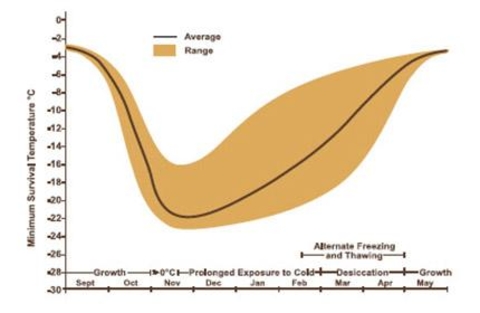Use winter-hardy varieties when planting winter wheat, especially if you’re not planting into residue or you’re seeding past the optimum planting window.
Late-planted seedlings will be small as winter approaches and more prone to winter injury, particularly if there’s little snow cover during winter. A winter-hardy variety will help reduce the risk of crop injury and are more productive in conditions conducive to winter injury.
Study results: Winter hardiness of currently available varieties
Cold acclimation and vernalization
Winter wheat undergoes two important physiological changes in the fall when the plants are exposed to cooler growing conditions: Cold acclimation and vernalization.
Cold acclimation is needed to induce the winter hardiness that allows the plant to survive the freezing temperatures during the winter months. Vernalization enables reproductive growth and allows winter wheat to reach flowering earlier the next summer.
Both vernalization and cold acclimation require a period of growth when temperatures are between 30 and 60 degrees Fahrenheit, with near 40 being optimum.
Late planting
If the vernalization requirement is only partially met in the fall because of late planting, it will delay maturity the next summer, as day length will eventually trigger reproductive growth. The period needed for vernalization differs among winter wheat varieties.
Likewise, the winter hardiness differs among winter wheat varieties. The most winter-hardy varieties can withstand crown temperatures as low as -15 degrees for a short period of time (Table 1).
Table 1: Maximum number of days winter wheat can survive at different crown temperatures.
| Temperature | Maximum length (days) |
|---|---|
| 27.0F | 150.0 |
| 5.0F | 6.0 |
| -15.0F | 0.5 |
| -20.0F | 0.0 |
Changes in winter hardiness
Winter hardiness is not a static condition.
Canadian research has demonstrated that winter hardiness follows a bell-shaped curve in which hardiness increases during the fall, peaks between December and February and decreases in early spring. This is shown in Figure 1, which details the changes in winter hardiness of Norstar Canadian Western Red Winter Wheat (CWRW) over period of September through May.
Factors such as the following hasten the loss of hardiness: A mid-winter thaw, alternate freezing and thawing, frost heaving, desiccation, suffocation (due to ice sheeting) and rain.
Reviewed in 2021


